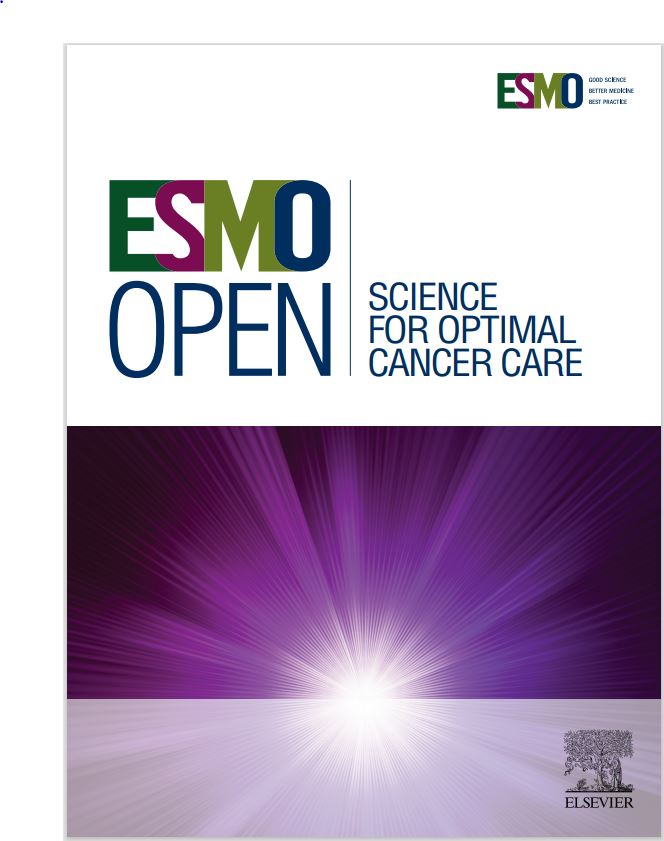A phase I, first-in-human trial of KO-947, an ERK1/2 inhibitor, in patients with advanced solid tumors
IF 7.1
2区 医学
Q1 ONCOLOGY
引用次数: 0
Abstract
Background
KO-947, a potent, intravenously administered, extracellular signal-regulated kinase (ERK) inhibitor, has demonstrated activity in preclinical models. This phase I trial of KO-947 evaluated maximum tolerated dose (MTD), safety, and pharmacokinetics in patients with relapsed/refractory solid tumors.
Materials and methods
This multicenter, open-label, dose-escalation study evaluated KO-947 0.45-11.3 mg/kg in three schedules. Schedules 1 (0.45-5.4 mg/kg, 1- to 2-hour infusion) and 2 (4.8-9.6 mg/kg, 4-hour infusion) were administered once weekly on a 28-day cycle. Schedule 3 (3.6-11.3 mg/kg, 4-hour infusion) was administered on days 1, 4, and 8 (and on days 11 and 15 for two patients) on a 21-day cycle. The primary objective was determination of MTD and/or recommended phase II dose. Safety analysis included adverse events of special interest (AESIs), namely ocular toxicities and infusion-related reactions (e.g. hypotension, corrected QT interval prolongation). Results from the dose-escalation portion of the phase I study are presented due to trial termination before preplanned cohort expansion cohorts.
Results
All 61 enrolled patients (schedules 1/2, n = 34, schedule 3, n = 27) discontinued treatment, mostly owing to disease progression (88% and 67%). The MTD for schedule 1 was 3.6 mg/kg; the maximum administered doses for schedules 2 and 3 were 9.6 and 11.3 mg/kg, respectively. Treatment-related adverse events occurred in 88% of patients in schedules 1/2, and 92% in schedule 3; most common were blurred vision (schedules 1/2, 50.0%; schedule 3, 33.3%). AESIs occurred in 50% of patients in schedules 1/2, and 82% in schedule 3. In all schedules, the best overall response was stable disease.
Conclusions
Intravenous KO-947 had a generally tolerable safety profile with minimal gastrointestinal toxicity compared with oral administration of other ERK inhibitors.
求助全文
约1分钟内获得全文
求助全文
来源期刊

ESMO Open
Medicine-Oncology
CiteScore
11.70
自引率
2.70%
发文量
255
审稿时长
10 weeks
期刊介绍:
ESMO Open is the online-only, open access journal of the European Society for Medical Oncology (ESMO). It is a peer-reviewed publication dedicated to sharing high-quality medical research and educational materials from various fields of oncology. The journal specifically focuses on showcasing innovative clinical and translational cancer research.
ESMO Open aims to publish a wide range of research articles covering all aspects of oncology, including experimental studies, translational research, diagnostic advancements, and therapeutic approaches. The content of the journal includes original research articles, insightful reviews, thought-provoking editorials, and correspondence. Moreover, the journal warmly welcomes the submission of phase I trials and meta-analyses. It also showcases reviews from significant ESMO conferences and meetings, as well as publishes important position statements on behalf of ESMO.
Overall, ESMO Open offers a platform for scientists, clinicians, and researchers in the field of oncology to share their valuable insights and contribute to advancing the understanding and treatment of cancer. The journal serves as a source of up-to-date information and fosters collaboration within the oncology community.
 求助内容:
求助内容: 应助结果提醒方式:
应助结果提醒方式:


